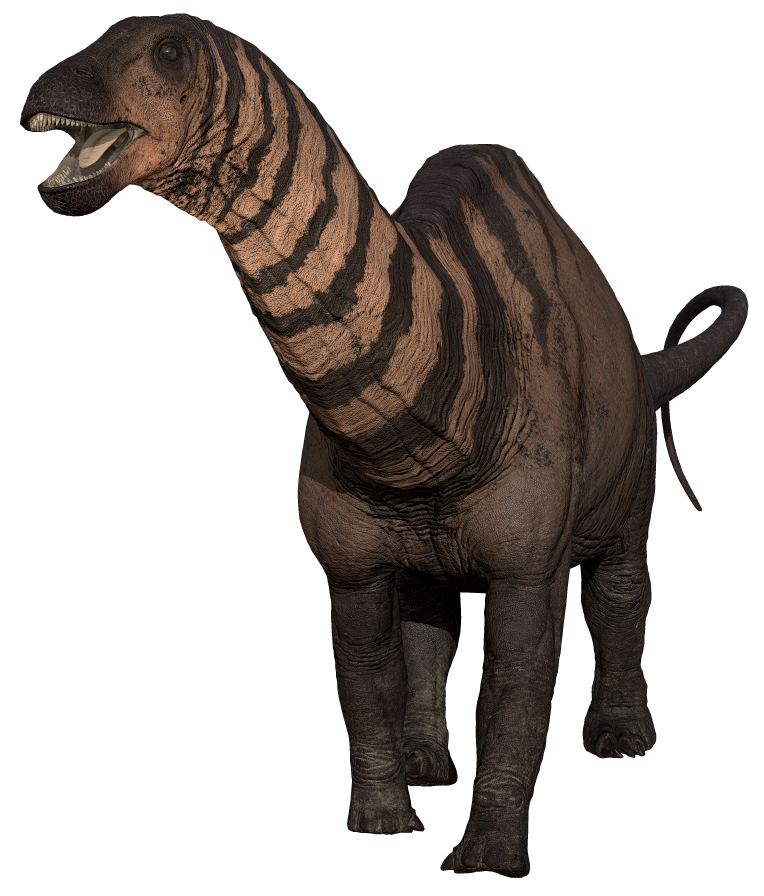The Little Giant of Late Jurassic Tanzania
As a sauropod, Dicraeosaurus was a giant by the standards of most animals, but by sauropod standards, it was a dwarf among giants. This strange sauropod demonstrates the variety of ecological roles this group filled during the Late Jurassic.
Overview: Like elsewhere in the Late Jurassic, Tanzania was a land of giants, but one of these giants was smaller than the rest. As a sauropod, Dicraeosaurus was a big animal, but it was rather small by sauropod standards, dwarfed by its brachiosaurid neighbor, Giraffatitan, one of the largest Jurassic sauropods. This little giant, discovered in the early 20th century, demonstrates the variety of ecological roles sauropods filled at this time.
Discovery: Dicraeosaurus was discovered in the Late Jurassic Tendaguru Formation in the Lindi Region of Tanzania. It was described and named in 1914 by German paleontologist Werner Janensch. Its name is Greek, meaning “birfucated lizard”, referring to the Y-shaped bifurcated neural spines on its vertebrae.
Evolution, Description, and Ecology: Dicraeosaurus was a sauropod, and like other sauropods, it had a large rotund body, pillar-like legs, and a proportionally small head and long neck and tail. However, as a dicraeosaurid sauropod, it differed from many other sauropods, including its cousins in the family Diplodicidae. Dicraeosaurids were generally small by sauropod standards and had proportionally shorter necks and larger heads. Dicraeosaurus had elongated and bifurcated vertebral spines, which served as muscle attachments in its relatively thick neck. However, it lacked the hyper-elongated neck spikes of its close dicraeosaurid relative Amargasaurus. Dicraeosaurus reached lengths of 14–15 meters (46–49 ft) and weighed about 5–6 tonnes (5.5–6.6 tons), making it similar in size to an elephant, just more elongated. Like its cousins the diplodocids, Dicraeosaurus and its kin probably held their necks horizontally, and so probably weren’t high browsers, instead being grazers or low browsers, with a likely maximum browsing height of 3 meters (9.8 ft), feeding higher than the stegosaur Kentrosaurus, but much lower than the enormous giraffe-like brachiosaurid Giraffatitan which was a high browser, and weighed over seven times as much as Dicraeosaurus. These different herbivores are a prime example of niche partitioning, where animals specialize on different food sources, in this case, browsing heights, to avoid competition with each other. Dicraeosaurus would have been hunted by large theropods, including possible ceratosaurids, Torvosaurus or a similar animal, and Veterupristisaurus, the earliest known carcharodontosaur.
Extinction and Legacy: Why Dicraeosaurus went extinct is unknown, but at the end of the Jurassic Period, many species and clades were replaced in the faunal turnover that happened between the Jurassic and the Cretaceous, possibly caused by climate change, the breakup of Pangea, and/or changes in vegetation and the diversification of new kinds of herbivores. Dicraeosaurus can be seen in the Museum für Naturkunde, in Berlin, Germany.
Dicraeosaurus FAQ
Dicraeosaurus size / How big was an Dicraeosaurus?
See height, weight, and length.
Dicraeosaurus height / How tall was Dicraeosaurus?
Dicraeosaurus was probably around 3.68 meters (12 ft) tall.
Dicraeosaurus weight / How much did Dicraeosaurus weigh?
Dicraeosaurus weighed about 5–6 tonnes (5.5–6.6 US tons), rather small by sauropod standards, but similar to a modern African elephant!
How long was Dicraeosaurus?
Dicraeosaurus is thought to have been 14–15 meters (46–49 ft) long.
What did Dicraeosaurus eat?
Dicraeosaurus ate plants, probably low-growing vegetation like ferns and horsetails.
What is Dicraeosaurus’s closest living relative?
Like all dinosaurs, the closest relatives of Dicraeosaurus are the only surviving lineage of dinosaurs today, the birds. Crocodilians, while not dinosaurs themselves, are also more distant cousins of dinosaurs.
Dicraeosaurus family members / Dicraeosaurus family / What kind of dinosaur was Dicraeosaurus?
Dicraeosaurus was a sauropod (a “long-necked” dinosaur) in the family Dicraeosauridae, which was in turn in the superfamily Diplodocoidea, making it a distant cousin of much larger and longer sauropods like Diplodocus and Apatosaurus!
Where did Dicraeosaurus live? / Where was Dicraeosaurus found?
Dicraeosaurus lived in what is now Tanzania.
When did Dicraeosaurus live?
Dicraeosaurus lived about 155-150 million years ago in the Late Jurassic Period.
What does Dicraeosaurus mean? / Dicraeosaurus name meaning
Dicraeosaurus means “birfucated lizard”, referring to the Y-shaped bifurcated neural spines on its vertebrae.

